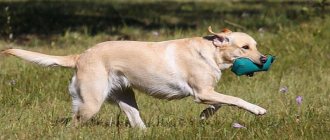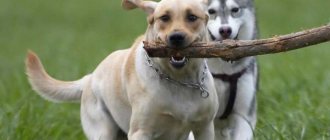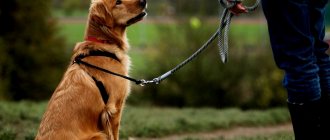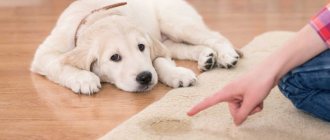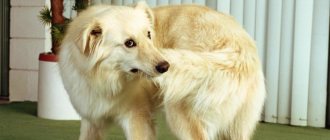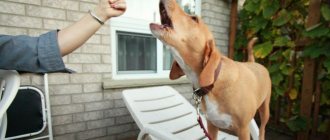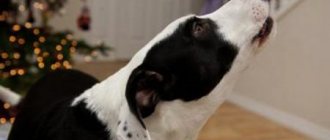Different situations - different approaches
To choose the right learning method, you need to consider several factors:
- Age : puppy or adult animal;
- Where did you get the dog : bought a puppy, adopted an adult dog from other owners, or picked up an animal from the street;
- Education : knowledge of basic commands (“Come to me”, “Fu”, “Lie down”, “Sit”);
- Temperament characteristics : calm or impulsive animal.
Age is a key factor. It is easier for a puppy to learn because it has not yet developed a stable behavior pattern. An adult dog, like an adult human, tends to act out of habit. This habit is not easy to “break”: it takes a lot of time and effort.
The second factor is no less important. The puppy does not yet divide his behavior into right and wrong - it’s time to teach him how to do this. It is much more difficult with an adult dog who has lived in a kennel and stray animals - they need to prove that they cannot go to the toilet whenever and wherever.
Other factors indicate the complexity and duration of training. Of course, it will be easier if the dog already knows how to do something and behaves quite calmly. If this is not the case, you will have to look for methods of pacification and additional motivation for the dog (for example, not only a treat, but also a game).
Ideal age
When talking about the age at which you need to teach a dog to go to the toilet outside, experts disagree. According to the most common opinion, the ideal age is 4-6 months. It is during this period that the puppy begins to correlate desires with actions. By this age, he is developing quite well physiologically, which allows him to endure, and not defecate at the first whim.
Preparation
When teaching your puppy to relieve himself outside, you need to remember four things:
- A dog is not a robot. At first, success and failure may alternate. If the puppy went to the toilet twice outside, and the third time at home, there is no need to sound the alarm. He needs time to adapt to new requirements.
- First, you will have to control literally every movement of the puppy. You need to learn to understand whether he wants to go to the toilet or not. Moreover, understand immediately, and not immediately before the undesirable action.
- It is better to start training your puppy to go to the toilet outside if he is accustomed to defecating in the same place in the house. You can do without this, but it will be more difficult.
- You will have to go outside up to 10-12 times a day. It may happen that you have to take your dog outside at 2-3 am.
Learning process
- Choose a few free days during which you can be at home. These may be weekends or holidays. Plan your time so that you don't have to leave home.
- Prepare a treat. If you walk your puppy with a collar and leash, prepare them too.
- Watch your puppy carefully. When you see him about to relieve himself, immediately take him outside. The faster the better.
- If possible, choose the quietest place where the dog will not be disturbed by outside factors.
- Avoid dog walking areas, children's playgrounds, and places near highways.
- Release the puppy. If you are not using a leash, simply let the animal out of your hands. If you are walking on a leash, let your dog fly freely away from you. Do not disturb the puppy by tugging on the leash or calling.
- Wait until the puppy goes to the toilet.
- Instantly praise him and reward him with a treat.
These steps should be repeated every time your puppy needs to go to the toilet. The most important thing is to be systematic (at least for several days in a row).
You cannot be lazy and allow your puppy to go to the toilet at home if you have already started teaching him to do it outside.
You should not take your puppy home immediately after he defecates. You need to walk for at least another 10-15 minutes to make your trip outside more or less a full-fledged walk.
It will be great if during this short walk the puppy goes to the toilet one more time. Naturally, the pet needs to be praised every time.
If you decide to reward your puppy with a treat, you need to do this every time, without missing the reward.
Do not be surprised
- Puppies have a very fast metabolism. They may go to the toilet very often. Dogs begin to tolerate it only from the age of six months.
- A puppy under 4 months of age may not be physically able to restrain himself. Therefore, training started too early will be stressful for both you and him.
- A young dog, rejoicing at the owner’s arrival home, can “pee with joy” right in the hallway. You can't blame him for this.
Teaching an adult dog
An adult dog relieves itself on the street
First we need to decide what kind of dog we are dealing with:
- The dog lived in an apartment or in a house with another owner;
- The dog lived in a booth;
- The animal was picked up from the street.
If an adult dog, accustomed to living indoors, refuses to go outside to the toilet, most likely he is simply not used to the new environment. She can be slightly scolded for defecating at home, but nothing more. You cannot create stressful situations - this interferes with the adaptation process. When the animal gets used to its new home and owner, it will behave as before.
If the dog lived in a kennel or was stray, you will have to train it from scratch. Such an animal is accustomed to relieve itself in any place accessible to it. Teaching an adult dog to go to the toilet outside is much more difficult than teaching a puppy.
Peculiarities
- An adult animal can tolerate it. It is enough to take the dog outside 3-4 times a day.
- You can punish a dog, but not cross acceptable boundaries.
- You don’t need to be at home all the time and control your pet’s movements.
Principles of training
In the case of an adult dog, there is no clear procedure. You need to remember the basic principles of the owner’s behavior, and then act according to the situation.
- If there are signs that the dog wants to go to the toilet, you need to immediately take it outside. The algorithm is the same as in the case of training a puppy.
- You can punish your dog by lightly hitting it on the withers. It is better not to hit the animal with your hand. The owner's hand should be associated with a treat, not with punishment. To do this, you can take, for example, a newspaper. Don't try to hurt the dog. Your task is to show that the animal did wrong, and not to demonstrate physical superiority.
- If you catch an adult dog in the process of defecating, immediately scold him and stop him from finishing the process. Take the contents outside and wait for the dog to finish what he started there.
- The place where the dog relieved itself must be treated with a disinfectant to remove even the slightest odor. You can use a special spray to wean dogs from relieving themselves at home.
What to do if your dog refuses to go to the toilet outside
If puppies whine at night and childhood illnesses go away over time, then wet spots are much more difficult to deal with, especially if you have not taught the puppy to “toilet chores” from early childhood. Sometimes this problem reaches incredible proportions. Therefore, it is advisable to prevent such things from happening so that no misunderstandings arise when raising a puppy.
Of course, if this does not happen regularly, but only by accident, that is, for some reason the dog could not wait until it was time for a walk, there is nothing to worry about. But if wet puddles and piles appear in your apartment with frightening consistency, then the matter requires immediate intervention, since the consequences, as mentioned above, can be irreversible.
When your puppy is still small, it is better to purchase a special tray for him where he can go to the toilet. The same applies to an adult dog that has recently been sick or has been vaccinated. In this case, she should be trained to use the tray. As a last resort, you can lay newspapers on the floor in those rooms where the dog is most often, for example, in the hallway or in the living room.
But before teaching a puppy to go to the toilet outside , you need to remove all the newspapers from the floor, so that when walking he looks not for the newspapers he is used to, but for ordinary soil or wood.
If this method does not help, then in the house, in the place where the tray used to be, you need to put a bowl for the dog, since dogs do not go to the toilet in the place where they used to sleep or eat.
But, if the dog already goes for walks outside, but still relieves itself in the apartment, do not attack it with screams and curses - you will only aggravate the problem.
What to do in this case? Nothing! Just remove the dirt and ignore the dog for a while.
You will have to come to terms with the fact that at first the dog will constantly “mark” in the corners. But this is only temporary. Your success depends only on your perseverance and patience.
When training a puppy or dog to use the “outdoor toilet”, you need to take it for a walk at least 4-5 times a day. Typically, “surprises” occur shortly before sleep and immediately after sleep. Therefore, as soon as she wakes up, she needs to immediately get dressed and go outside. The same should be done before evening sleep.
When the dog does everything correctly, that is, goes to the toilet not at home, but outside, do not forget to praise him and treat him with something tasty so that he understands what your walks are for.
After your dog pees, don't rush home. Stay outside with her for a while - play or talk. It is very important to play with the dog only after all “things” have been completed, so that the dog realizes that all praise, all games and treats occur only after the “toilet”.
It is advisable to make a small schedule in which you will go to the toilet in order to approximately know the frequency. This will make it much easier for you to determine the time and duration of your walk.
After some time, you need to gradually increase the interval between exits , starting from 10 minutes. In about a month everything should be back to normal.
If you do not have the opportunity to take your dog outside on time, then try to close all the doors in the rooms and leave the dog in the kitchen or hallway. In this case, you will be confident in the cleanliness of your things, so you will avoid many troubles.
But it doesn’t always happen that a dog goes to the toilet in an apartment only because of his stubbornness or inexperience. Illnesses also cause this behavior. For example, abdominal pain, poisoning or kidney problems provoke unexpected urges that the dog cannot tolerate. Therefore, before you scold your pet for “surprises,” take him to the veterinarian.
But in any case, you need to endure this difficult time for you and for the dog, since not all of them learn to go to the toilet outside in the first year of their life. Although each breed has its own characteristics, so some puppies begin to go outside after a year, while their peers have been relieving themselves outside for a long time.
Another reason why a dog refuses to go outside may be the cold . This problem is completely solvable. For example, you can dress your dog warmer. Recently, a huge number of special salons for sewing clothes for dogs have opened.
The second option is to reduce the walking time. Usually in cold weather dogs do their business quickly, so after a couple of minutes they are already asking to go home.
You should not refuse them, otherwise they may refuse to go for a walk next time.
The reason for refusing to go to the toilet outside may be the presence of other dogs . If this is the case, then you should choose areas where other dogs do not roam, as their barking can distract and frighten your dog.
But often the presence of other animals can be the solution to your problem. Since most dogs like to “mark” those places where another dog has gone to the toilet, this is a fight for territory. Therefore, do not scold your dog for sniffing a tree where another dog just left his mark.
Of course, you don’t need to expect instant results, since training a dog to go outside is a rather difficult and lengthy process. But your persistence, and sometimes even stubbornness, and patience will allow you to achieve the desired success in a fairly short time.
Errors in education
The main thing in teaching a dog to relieve itself at home is not to spoil its psyche and not lose its trust. Often, due to lack of patience, a person may not be able to succeed in this. But it is necessary to remember that a puppy is a small child. He needs constant attention and care. He wants to go to the toilet at odd hours. But feeding strictly on a schedule can help here. If you constantly feed the puppy at the same time, then the owner will know how long after his pet wants to go to the toilet.
In the first days, the entire space where the puppy is located should be covered with diapers. He is small and not fast enough to run from one part of the room to another. You should also be careful. Any dog shows its desires by behavior. Perhaps she will spin around in one place, sniff a lot and crawl into hard-to-reach places. This is where you need to pay all your attention.
Note! A small pet still has little control over its natural body needs, so it is recommended to remove all diaper-like items from the floor: things, rags, soft toys.
Without understanding and trust, a puppy can be easily intimidated. You should not use physical punishment against a small child. It is enough to show dissatisfaction with the tone of voice. It would also be nice to introduce the “fu” command into everyday use. Owners often forget that the dog simply will not understand why he is being scolded if the punishment occurs too late. You should scold your pet only within a minute after the dirty deed has been done. The same goes for praise. But praise will only make the dog happy.
If you accidentally make a puddle in the wrong place, you need to remove it with a diaper, and only then wash it with detergent. Since dogs navigate more by smell, this will help them reinforce the skill. Cleaning and changing diapers must be timely.
It is impossible to force a puppy to wear a diaper against its will. Therefore, if the puppy wanted to go to the toilet, and then suddenly didn’t want to, you should wait again until he starts to sit down. The main thing in education is the dog’s trust in the person. Walking, playing together, etc. will help with this. If the pet has not mastered diapers in one way, you should move on to another.
Using diapers is a good way to toilet train your puppy, but it should not replace walking. After all, spending time in the fresh air strengthens the trusting relationship between the dog and the owner.
Author: Nazarenko Elena Alekseevna
Urination is the process of periodic voluntary emptying of the bladder into the external environment through the urethra. Toxic metabolic products are removed from the body through urine.
How to train a dog to go to the toilet outside?
At first, when the puppy is still very small and there is no way to take him out for walks, he does his business safely in the apartment (it’s good if you managed to get him to do this in strictly defined places). But, after the puppy can be taken out, the first thing to do is to accustom him to the fact that the toilet is located outside.
Walking rules
At first, the puppy should be taken outside quite often - as soon as he wakes up, after feedings and active games. This is due to the fact that at the age of up to 3 months, dogs still cannot endure for a long time. Therefore, the owner’s task is to anticipate the pet’s natural urges.
This period does not last long. As the dog grows up, it learns to control its physiological needs. Gradually, the number of walks per day is reduced to 2-3, depending on the capabilities of the owners and the characteristics of the breed (long and frequent walks are necessary for good health, for example, beagles and huskies).
Exceptions
Keep in mind that there are always unforeseen circumstances. For example, if you are late and no one can walk your dog at the right time, it is wrong to scold him for inappropriate behavior.
Source: https://petstory.ru/knowledge/dogs/dog-training/kak-priuchit-sobaku-khodit-v-tualet-na-ulitse/
How to toilet train a puppy at home and outside
From a very early age, puppies understand that dirtying their own nest is not good, and at the age of 3 weeks they begin to move away from it to go to the toilet.
This means that potty training a puppy should be a relatively simple task, as long as you don't ask him to do things that are beyond his understanding, but simply point him in the right direction and create natural conditions for him to do his thing.
Since toilet training is usually the very first training and guidance your puppy receives from you, it is important that you follow the right path. This first bonding experience will lay the foundation for your subsequent training efforts to begin teaching your puppy how to interact with you, as well as where to go to the bathroom.
When to start toilet training?
- When your puppy is very young (between the age when he is weaned and the age when he is able to go outside and meet other dogs) you will not be able to let him outside as often as he needs to. This can happen every couple of hours, and sometimes at night as well.
- However, puppy toilet training should begin as soon as your puppy is at least 8 weeks old. This is not only to ensure that he learns to go to the toilet in a designated area, but also to ensure that he does not harm his normal development when he moves from his usual living space to another place to do his business.
- You should always consider your puppy's age and understanding of his developmental level to begin training him, however, there is no such thing as "too young" for toilet training if the puppy has already been weaned!
- How to start
Install a litter box for your young puppy near the door through which you will later let him outside. Make sure this area is far enough away from food and water, but still within sight of his living area, so that the puppy feels safe using it.
Place something like a bedding or even newspaper in this area and reward your puppy every time he goes to the toilet in this area until you can let him outside.
The next step is to take your puppy outside and go to the toilet with him every one to two hours, and if he actually goes to the toilet, you need to praise him thoroughly. Over time, your puppy will grow and the intervals between toilets will become longer and longer, and you will be able to reduce the number of times you go outside.
Learn to recognize signals
- Your puppy may be telling you that he wants to go to the toilet, so you can recognize your puppy's course towards the door or towards the indoor toilet.
- If you notice this, try to intercept him on the way to the target and take him outside. Do this right away, don't make your puppy wait.
- It is important that your puppy understands that if he asks to go out, you will definitely respond to his needs.
- Soon enough, your puppy will come to understand this and will show clear signals of wanting to go to the toilet.
- Be alert when your puppy whines and scratches at the door, or sniffs and looks for a place to go to the toilet, or he may squat to urinate or begin to hunch over to defecate.
- At this point, if you are quick enough, you can reward your puppy for being patient for a second while you open the door, so he will learn to ask you to go to the bathroom in the future.
When to take your puppy to go to the bathroom
Once you have determined that your puppy is old enough to go at least 2 hours between bathroom breaks, use the following guidelines to encourage him to go outside:
- First time in the morning
- After he eats
- After play or excitement
- Last time - at night
- And whenever he asks you to leave
Create a positive experience
Make sure your puppy is happy and relaxed enough when going to the toilet. Stay with him in the garden so that he can concentrate on what he is doing and not on the fact that you are gone somewhere, but also be sure to give him enough space so that he does not feel cramped.
Reward your puppy with a treat or good praise after he goes to the toilet, this will help him form a positive association between toilet training and rewards.
Never punish your puppy for using the toilet incorrectly, for lack of understanding, or for not always doing everything correctly.
Treatment of dogs for cystitis
How to treat cystitis in dogs at home? First of all, you need to understand that there is no miracle pill - you need to treat your dog for cystitis comprehensively! This is a must. It is not enough to simply suppress symptoms and relieve pain. If you don’t find the cause of the disease and don’t eliminate it, then your dog’s bladder inflammation will definitely return. Relapses of this disease occur in almost 90% of cases. So, what to do if your dog has cystitis?
Conditions of detention
First of all, the conditions of detention are improved. All cold floor surfaces are “insulated”, or do not allow your pet to lie on tiles or concrete. It is better to arrange a bed with high sides to eliminate drafts. The room where the mustache is located should be warm. Just don't heat the bubble. Someone may advise doing this, but in reality it will only worsen the animal’s condition. Heat provokes an even greater increase in the number of bacteria, which makes inflammation (especially purulent) more difficult to eliminate, and the course of treatment for a dog with cystitis increases.
Antibiotics
For cystitis in dogs, antibiotics must be administered. Better intramuscularly. So they begin to act faster, and a high concentration of the active substance remains in the blood longer. If you give tablets, the results will be later than if you inject them into solutions into the muscles.
Catheterization and bladder lavage
It is necessary to empty the bladder of accumulated urine.
- Firstly, this will help reduce the risk of intoxication by urine breakdown products.
- Secondly, this will remove some pathogenic microorganisms from the bladder.
All this will lead to the fact that irritation of the mucous membrane of the bladder, if it does not stop completely, will decrease significantly. And this is a huge step towards the dog’s recovery from cystitis. You cannot do this yourself; you will need the help of a veterinarian. Through the inserted catheter, he will rinse the bladder with antiseptic solutions (for example, an aqueous solution of furatsilin). Antibiotics may be injected directly into the blister itself to “kill” the bacteria in it.
Antispasmodics
Antispasmodics will make it easier for the dog to have bowel movements - this is another type of drug in the treatment of cystitis in dogs. After taking them, the swelling will subside a little, due to which the urinary canal will expand and urine will be separated in large portions and will not stagnate. In addition, antispasmodics have analgesic properties. Your mustache will not experience that intense pain, although it will not completely disappear.
You can now view the current price of medications for cystitis in dogs and buy them right here:
Food and drink
In any case, it is necessary to review the diet and create a special diet for a dog with cystitis. Compose it more competently, observing the relationships between micro- and macroelements, proteins, fats and carbohydrates.
- While your dog is being treated for cystitis, exclude meat.
- But it is better to give fermented milk products, because due to the use of antibiotics, the intestinal microflora becomes poorer.
- And KMP restore it due to bifidobacteria and lactobacilli.
- You can give prebiotics or enterosorbents to “bind” antibiotics in the intestines, preventing them from destroying beneficial microorganisms.
Give clean water, do not limit it. A large amount of water will help reduce the concentration of harmful substances in urine (it will simply dilute it, making it less “aggressive” towards the inflamed mucous membrane). And if the urine is not concentrated, then emptying the bladder will become less painful. It will become easier for your pet to go to the toilet in small ways. The more he writes, the less bacteria will remain in the urine.
Traditional methods of treatment
Among the folk methods of treating a dog for cystitis at home, decoctions of lingonberry or bearberry leaves are widely used. You just need to be very careful when using them. And give them as an addition to drug treatment, and not as a replacement for it. These decoctions are known for their ability to heal the organs of the genitourinary system.
Good bactericidal properties, along with diuretics. By the way, diuretics can be given only when the swelling of the mucous membrane has disappeared and the inflammation itself has subsided significantly. Otherwise you will only make things worse. There will be a lot of urine, but the dog will not be able to “remove” it (the channel is too narrow, the mucous membrane is damaged, pain persists, or there is a fear that it will hurt again).
Don't self-medicate! All medications will be prescribed by a veterinarian after an in-person examination and the results of a urine and blood test! The bacteria that lead to the inflammatory process in the bladder may not be sensitive to the antibiotic YOU chose (or bought on the advice of a friend/neighbor/forum companion)! This will only “strengthen” the resistance of microorganisms to antibacterial drugs, which will greatly complicate the process of treating a dog with cystitis.
Tips on how to train a puppy to toilet in a diaper and outside
The task of how to toilet train a puppy must be approached with complete seriousness and responsibility, since this is not an easy matter.
On average, from 12 days of age, small pets begin to try to get out of their shelter and relieve themselves on their own. A small puppy will pee often - this will happen immediately after sleep, after eating, playing, in general - more than 10 times a day.
Until the puppy has had all its vaccinations, it is forbidden to walk it; accordingly, the owner should be patient and learn as much as possible about how to train a puppy to go to the toilet. It is recommended to engage in this activity immediately within 6–7 weeks of the pet’s life, since after this age it will be difficult to change the animal’s already established habits.
It’s better to approach the question of how to teach a puppy to go to the toilet within a limited area. It is recommended to expand the boundaries for the animal if it has been noticed that the pet is already accustomed to relieving itself in the appropriate place.
Toilet arrangement
To know how to train a dog to go to the toilet outside, you first need to spend a little effort to first train your pet to go to the toilet at home. There are several options for arranging this place for an animal:
- cover with newspaper or tear the paper finely;
- use special fillers;
- buy disposable diapers.
To train a puppy to use the toilet with newspapers or a diaper, it is recommended to use a tray without a mesh to prevent excess leakage.
In general, the litter box option is more suitable for cats. And since puppies do not have the reflexes to bury their excrement, they prefer to urinate on the newspaper.
To teach your dog to go to the toilet, you need to install a tray without high sides, on a flat surface and in a quiet corner. As a rule, when buying a pet, breeders claim that there is no need to toilet train the puppy; they have already done this themselves.
In most cases, they teach animals to relieve themselves on a newspaper or diaper. Therefore, it is important to clarify which toilet is best to use in the future.
Even at a young age, dogs choose a place to go to the toilet based on their own instincts. Most often, for these purposes, they choose places near the balcony, doors or under windows. It is quite possible to make the task of teaching a puppy to use a diaper or newspaper easier if you initially place the tray in the right place.
If you decide to get a dog, then for the first time, when you are toilet training it, it is better to remove all carpeting from the rooms. If the pet at least once feels that it is more pleasant and convenient to relieve itself on the rug, then it will be very difficult both to wean the dog from shitting at home and to teach it to do it in the right place. In addition, the smell absorbed by the soft surface can persist for a long time.
How to teach a diaper from a small age
- So how to train a puppy to wear a diaper? The smaller the pet, the more often it needs to relieve itself. He wants to go to the toilet immediately after all important procedures. You can use these actions to your advantage.
- For example, you can immediately after sleep take the animal to the tray for a diaper, and it is better not to leave it at this time; you need to try by all means to keep it in this place, but without playing. Nature will take its toll: the pet will start peeing sooner or later.
- After this procedure, do not forget to calmly praise the dog and additionally treat it with a treat. You need to demonstrate to the animal that the owner is satisfied with his behavior, which will be an excellent motivation for the dog.
- Do not delude yourself and think that the problem of how to accustom a dog to a diaper has been solved after the first successful attempt. The pet may not understand the explanations correctly, so it will continue to relieve itself in the wrong place.
- You just need to be patient and try to transfer the little puppy to the tray on time, not forgetting to praise him after the correct procedure.
A little time will pass, and the little pet will independently go to the toilet in a diaper in front of the owner, thus wanting to bring him joy and receive a well-deserved treat.
But once the pet has mastered the skills, it will need to be weaned off the treat. The first time you can give them every other time, then less and less, and then stop altogether.
In this way, we teach the animal to relieve itself without reward in the form of food, which will become a matter of course for it.
How to train an adult dog?
To teach an adult dog to use the toilet outside, you need to understand the reason why he does it at home.
Did the dog live on the street before? Did your previous owners teach you to use a litter box or a diaper? Or maybe she's just being mischievous, or intimidated?
First of all, it is necessary to exclude possible diseases by examining the dog at the veterinarian. And if everything is in order with health, begin the painstaking process, as with a small puppy, with the exception of the number of walks. It is advisable to constantly monitor your pet’s behavior, and as soon as she begins to show anxiety, go outside with her.
Don't forget to praise and reward with treats and pleasant walks for the dog after using the toilet.
You shouldn’t beat someone for an offense in the house, just show your dissatisfaction - after all, dogs perfectly understand the tone of speech and, almost on a mental level, guess what the owner likes and what he doesn’t.

